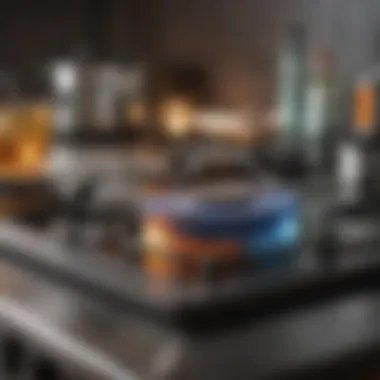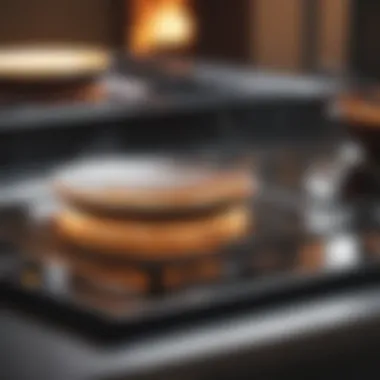Effective Strategies for Cleaning Electric Glass Stoves


Intro
Cleaning an electric glass stove top requires understanding its unique properties and the correct approach to maintain its clarity. An electric glass stove presents a modern aesthetic and offers numerous cooking advantages. However, maintaining its surface can be challenging due to stains and stuck-on food. This guide outlines effective strategies to keep your stove top in pristine condition, ensuring it remains functional and visually appealing.
To achieve optimal results, it is essential to utilize suitable materials and cleaning techniques. With a few practical tips and product recommendations, homeowners can effectively address common cleaning challenges. This article caters to those looking to elevate their cleaning routine, whether for everyday use or to prepare for special occasions. The emphasis is on clarity, functionality, and longevity for your stove top.
Understanding the mechanisms of cleaning will enable you to take a systematic approach. By following the strategies outlined herein, you can enjoy a serene cooking experience while showcasing the beauty of your kitchen.
Understanding Electric Glass Stove Tops
Electric glass stove tops have become a popular choice in modern kitchens due to their sleek design and practicality. Understanding the fundamental aspects of these appliances is crucial for effective maintenance and cleaning. This section will dissect the key components, materials, and benefits that characterize electric glass stove tops, providing a foundation for homeowners and kitchen enthusiasts.
Components of Electric Glass Stove Tops
An electric glass stove top generally comprises three essential components. Firstly, the ceramic glass surface serves as the cooking area, notable for its smooth and flat surface that facilitates easy cleaning. Secondly, the heating elements exist underneath the glass, responsible for generating heat. These elements can be either radiant or induction, each with distinct functionalities. Finally, there is the control panel, typically positioned at the front, which allows users to manipulate temperature settings effectively. Recognizing these components helps users understand how to clean and maintain the stove top properly.
Common Materials Used
Electric glass stove tops primarily employ a few key materials. Most notably, the ceramic glass itself is a tempered type known for its durability and heat resistance. This material, however, can become susceptible to scratches and stains if not cared for properly. The heating coils are typically made from metal alloys, while the control panel often incorporates plastic or stainless steel. Acknowledging these materials is essential, as the cleaning methods will differ according to the specific type of material involved.
Benefits of Electric Glass Stove Tops
The advantages of electric glass stove tops merit serious consideration. Primarily, their aesthetic appeal adds a level of elegance to any kitchen. The smooth surface not only looks good but also simplifies cleaning, as spills can be wiped away easily. Moreover, electric glass stove tops often heat up quickly, enhancing cooking efficiency. Many models also offer features such as temperature control and safety mechanisms, which further improve usability. Overall, the combination of practicality and style makes electric glass stove tops a versatile choice for both novices and seasoned chefs alike.
Essential Cleaning Supplies
Cleaning an electric glass stove top effectively hinges on using the right supplies. Having the appropriate cleaning materials not only enhances the efficiency but also protects the surface from scratches and damage during the cleaning process. Right supplies are essential for maintaining the stove top's clarity and optimal function.
Recommended Cleaners
When selecting cleaners, it is crucial to pick options that are both effective and safe for glass surfaces. Here are popular choices:
- Cerama Bryte: This cleaner is designed specifically for glass stove tops. It effectively cuts through grease and burnt-on food without harming the surface.
- Bar Keepers Friend: Known for its versatility, this cleaner can eliminate stains and provide a polished finish. It is non-toxic and safe for regular use.
- Vinegar: A natural cleaner, white vinegar can help remove stains and restore shine. It is an effective solution for daily maintenance.
- Baking Soda: This is a gentle abrasive that can assist in lifting stubborn stains while being safe for the glass surface.
Using pH-balanced or specifically formulated cleaners is critical to avoid damage. Avoid abrasive or harsh chemicals to protect your stove top.
Tools Required for Cleaning
In addition to cleaners, having the right tools is vital for thorough cleaning. The following tools might be necessary:
- Soft Cloths or Microfiber Towels: These are essential for wiping surfaces without scratching.
- Spatula or Scraper: A plastic scraper can assist in removing burnt-on food without damaging the glass.
- Sponge with a Soft Side: Soft sponges can help in applying cleansers without causing scratches.
- Spray Bottle: Useful for dispensing vinegar or other cleaning solutions in a controlled manner.
- Steam Cleaner: For deep cleaning, a steam cleaner can effectively remove stains and sanitize without harsh chemicals.
These tools have a significant role in achieving a clean surface. Using soft materials minimizes the risk of scratches.
Safety Equipment to Consider
Safety during the cleaning process should never be overlooked. Here are some safety considerations:


- Gloves: Wearing rubber or latex gloves can protect your skin from chemical irritation.
- Protective Eyewear: If using strong cleaners, goggles can shield the eyes from splashes.
- Apron: A cleaning apron can protect clothing from stains and spills.
Practicing safety helps in avoiding accidents and injuries. Taking precautions can ensure a more effective cleaning experience.
Cleaning Process Overview
Cleaning an electric glass stove top requires a specific approach to maintain its clarity and functionality. This section outlines essential steps, significantly contributing to the overall maintenance of the stove. A systematic cleaning process not only helps to remove dirt and residues but also enhances the lifespan of the appliance. Understanding this process is a key benefit for homeowners who value their kitchen's aesthetics and efficiency.
Initial Preparation
Before beginning any cleaning, initial preparation is crucial. This stage involves gathering all necessary materials and ensuring the stove is completely cool to prevent burns. A well-prepared environment boosts efficiency and minimizes the risk of damage. It is advisable to remove any loose items from the stove surface, as they can hinder the cleaning process. Clear space allows for better access to all areas of the stove.
Steps for Effective Cleaning
Removing Burnt-On Residue
Burnt-on residue is a common challenge for electric glass stove tops. This removal process is integral to achieving a clean surface. The key characteristic of this step is the use of a specialized cleaner designed to dissolve tough stains and food particles. Many homeowners find this approach beneficial due to its ability to restore the stove's appearance. However, some cleaners can be harsh and potentially damaging if misused. The unique feature of this step relies on patience and the right products, making it effective yet requiring careful application.
Polishing the Surface
Polishing the stove surface won't just improve its look; it also provides a protective layer against future stains. The main element of this step involves using non-abrasive products or homemade solutions. This practice is popular because it enhances the shine while ensuring no scratches occur during cleaning. However, it is essential to use the right materials to avoid damage. The unique feature here lies in the dual functionality of polishing: achieving aesthetic appeal while providing ongoing maintenance.
Rinsing and Drying
Rinsing and drying is a vital final step that ensures no cleaning residues remain on the stove. This process can prevent any build-up that may lead to stains over time. The key characteristic involves using a clean cloth and warm water, creating an effective rinse cycle. This step is beneficial as it properly prepares the surface for usage post-cleaning. However, neglecting to dry the stove correctly may lead to streaks, diminishing the cleanliness achieved. The unique aspect here centers on attention to detail to guarantee optimal results.
Post-Cleaning Inspection
After cleaning, conducting a thorough post-cleaning inspection is vital. This phase involves checking for any missed spots or residues and assessing the overall appearance. Paying attention to the details in this phase solidifies the cleaning process. If issues are found, further cleaning steps may be necessary to achieve the desired results. Routine inspections will make a significant difference over time, allowing homeowners to maintain their electric glass stove tops in top condition.
Specific Cleaning Techniques
Cleaning an electric glass stove top is not just about removing grime; it also involves preserving the surface for long-term use. Specific cleaning techniques can make a significant difference in both the appearance and longevity of your stove. By understanding and implementing these methods, users can maintain a clear, attractive surface while ensuring it continues to function effectively.
Utilizing Baking Soda
Baking soda proves to be a versatile and powerful cleaning agent. It is effective in tackling stubborn stains and sticky residues that accumulate over time. When used correctly, baking soda can remove burnt-on food without causing damage to the glass surface. Its mildly abrasive nature provides just enough scrubbing power to lift grime while being gentle enough to prevent scratching.
To utilize baking soda:
- Make a Paste: Combine a quarter of a cup of baking soda with water. Mix until it forms a thick paste.
- Apply the Paste: Spread the paste over the stained areas of the stove top. Let it sit for at least 15 minutes to penetrate the residue.
- Scrub Gently: Use a non-abrasive sponge or cloth to scrub the paste into the surface. Rinse with clean water to remove any residue.
- Dry the Surface: Finish by wiping the surface with a soft cloth to avoid streaks.
This technique is advantageous for both its cleaning power and affordability. Baking soda is safe for the environment and poses no health risks when used in cooking spaces.
Using Vinegar as a Cleaner
Vinegar is another household staple that serves as an excellent cleaner for electric glass stove tops. The acidity in vinegar helps dissolve grease and grime, making it easier to clean contaminants that could hinder the stove's performance.
To clean with vinegar:


- Mix a Solution: In a spray bottle, mix equal parts of distilled white vinegar and water.
- Spray the Solution: Generously spray the vinegar solution over the surface of the stove top, especially targeting the stained areas.
- Let it Sit: Allow the vinegar to sit for about 10 minutes to break down any stubborn substances.
- Wipe Down: Use a soft rag or microfiber cloth to wipe the surface clean, removing any stains and residues.
- Final Rinse: Rinse the cloth and wipe down again to ensure no vinegar remains, as the acidic residue can dull the surface over time.
Vinegar is not only effective but also safe. It is non-toxic, making it an ideal choice for households concerned about chemical exposure.
Scrubbing Techniques and Tools
The right scrubbing techniques and tools can enhance cleaning efficiency. It is crucial to select tools that will not scratch the glass surface while being effective in removing dirt.
Some techniques include:
- Use Non-Abrasive Sponges: Stick to sponges specifically designed for glass or non-scratch scrubbers. Avoid steel wool or harsh scrubbers that can cause scratching.
- Circular Motion for Scrubbing: When scrubbing the surface, use circular motions to minimize the risk of scratches and ensure an even clean.
- Avoid Excessive Pressure: Let the cleaning agents do the work. Applying too much force can result in more harm than good. Light pressure is often enough to lift stains and food particles.
In addition:
- Remember to Rinse Tools Regularly: While cleaning, it’s important to rinse your sponge or cloth frequently. This prevents the distribution of dirt back onto the stove top.
- Clean the Tools: After completing your cleaning, make it a habit to wash your cleaning tools to avoid future cross-contamination.
By implementing these specific cleaning techniques effectively, you can extend the life of your electric glass stove top and maintain its functionality.
These methods are not just about immediate cleanup; they help ensure a consistently clear and functional cooking surface.
Preventive Maintenance
Preventive maintenance plays a crucial role in ensuring the longevity and functionality of an electric glass stove top. By implementing a consistent cleaning routine and adhering to best practices, homeowners can avoid the accumulation of stubborn stains and wear. This proactive approach not only enhances the appearance of the stove but also contributes to its efficient functioning. Regular care helps in reducing the frequency and intensity of deep cleaning, thereby saving both time and effort.
Routine Cleaning Schedule
Establishing a routine cleaning schedule is essential for managing the cleanliness of your electric glass stove top. It is advisable to clean the surface after each use. Wiping down the stove post-cooking prevents food particles and spills from drying and hardening, making future cleaning easier. Additionally, a deeper clean should be conducted weekly to eliminate any residual grime.
In your routine, consider the following:
- Daily cleanup: Use a soft cloth or paper towel with a mild cleaner to wipe the stovetop after each use.
- Weekly maintenance: Dedicate time to a thorough cleaning using specialized stove top cleaners and a non-abrasive pad.
- Monthly inspection: Review the surface for potential scratches or damage and address them promptly.
By maintaining this schedule, you will help to preserve the luster of the glass surface and minimize the formation of difficult-to-remove residues.
Best Practices for Use
Using your electric glass stove top with care can greatly impact its maintenance. Here are some best practices:
- Use cookware with smooth bottoms: Pots and pans with rough surfaces can scratch the glass. Opt for flat and smooth-bottomed cookware.
- Avoid dragging pans: Lifting pots instead of sliding them reduces the risk of scratching.
- Be cautious with heat: Rapid temperature changes can cause thermal shock. Gradually increase or decrease heat settings.
These precautions help to protect the glass from damage and extend its life.
Storing Cleaning Supplies
Proper organization of cleaning supplies is often overlooked but is quite significant. Keeping your cleaning tools handy, yet organized, can streamline the maintenance process for your stove top. Here are some suggestions:
- Designate a storage area: Use a cabinet or a drawer specifically for cleaning supplies.
- Label products: Clearly labeling cleaning agents can help in quick identification and ensure you are using appropriate ones for the glass surface.
- Keep tools accessible: Consider a caddy or basket to hold your scrubbing pads, microfiber cloths, and cleaners together for easy access.
Efficient storage of cleaning materials not only simplifies the process but also encourages regular maintenance, leading to a well-kept stove top.


Troubleshooting Common Issues
Troubleshooting common issues with electric glass stove tops is essential for maintaining their aesthetic appeal and functionality. These problems can arise unexpectedly and may affect cooking efficiency. Understanding how to identify and rectify these concerns can not only save time but also prevent potential damage. It is important to address these issues as they can impede the user experience and may lead to costly repairs if left unresolved.
Scratches on the Surface
Scratches can occur on electric glass stove tops due to various reasons, such as the use of abrasive cleaners or cookware with rough bottoms. Once scratches appear, they can diminish the clear surface of the stove, impacting its overall appearance. To avoid this issue, it is wise to use smooth-bottomed cookware. If scratches do occur, there are tools designed to repair minor surface scratches. Products that contain cerium oxide can be effective in polishing out light abrasions. However, if the scratches are deep, it may be necessary to consult a professional to assess possible repair options, as deep scratches might compromise the integrity of the stovetop.
Discoloration and Stains
Discoloration and stains are common and often unsightly issues faced by electric glass stove top users. High temperatures combined with spills can lead to permanent stains if not cleaned promptly. Prevention is key; always wipe up spills immediately to prevent damage. For existing stains, a mixture of baking soda and water can be an effective solution. Apply the paste to the area, let it sit for a few minutes, and then gently scrub with a soft cloth. In some cases, vinegar diluted in water can also help to restore the shine and remove mild discoloration. Persistent stains, however, might require specialized glass cooktop cleaner to fully remove without scratching the surface.
Burnt-on Food Residue
Burnt-on food residue can be one of the more frustrating problems to encounter. This occurs after cooking where food gets heated and adheres to the surface. Removing burnt-on residue is crucial as it can lead to further stains and even impact cooking performance. A common approach is to use a scraper specially designed for glass surfaces. It is important to use this tool gently to avoid scratching the glass. Additionally, soaking the area with a damp cloth for several minutes can soften the residue, making it easier to remove. A paste of baking soda mixed with water can further loosen stubborn spots. If these methods fail, consider using commercial-grade cooktop cleaner that is safe for glass surfaces. Ensuring the stovetop is clean will contribute to a more efficient cooking process and improve the longevity of the appliance.
Comparative Analysis
The comparative analysis section aims to provide crucial insights into how electric glass stove tops stand against traditional cooktops. Understanding the differences betwen these two types of cooking surfaces is important for anyone considering a kitchen upgrade or evaluating the efficiency of their current appliance. Each type offers unique benefits and drawbacks that can affect cooking experience, cleaning routines, and overall kitchen aesthetics.
Electric Glass Stove vs. Traditional Cooktops
Electric glass stove tops differ significantly from traditional cooktops, which may include coil or gas types. One major distinction is the surface design. Electric glass stove tops have a sleek, smooth finish that enhances the kitchen's modern appearance. This can contribute to a feeling of sophistication and cleanliness. In contrast, traditional cooktops often have exposed elements or grates, which can be more challenging to clean.
Electric glass stove tops are known for their speed and efficiency. They heat up quickly and offer even heating across the cooking surface. This is particularly useful for tasks like simmering or sautéing, where precise temperature control is needed. Traditional cooktops may take longer to heat and can sometimes lead to uneven cooking surfaces, which is not ideal for all culinary endeavors.
Another consideration is safety. Electric glass stove tops remain hot even after cooking has stopped, while traditional gas burners may cool more quickly. This necessitates caution, especially in households with children.
Cost and Efficiency Considerations
The cost aspects of electric glass stove tops versus traditional cooktops can vary widely. Initial purchase prices might be higher for electric models, but they often offer lower energy costs in the long run. Electric glass stove tops generally use energy more efficiently.
Efficiency is also tied to maintenance. Electric glass stove tops require specific cleaning supplies and techniques. However, once one understands the proper care routines, the effort might result in a cleaner and more aesthetically pleasing cooking surface than traditional models can offer.
- Energy consumption: Electric glass stove tops often consume less energy, which can contribute to lower utility bills.
- Functionality: The sleek design allows for modern cookware compatibility, enhancing the overall cooking experience.
Finale
Understanding the significance of maintaining an electric glass stove top is critical. This article encapsulates key strategies for ensuring that such appliances remain functional and visually appealing. Regular cleaning and preventive maintenance directly impact the longevity and performance of the stove.
Summarization of Key Points
The discussion on cleaning strategies emphasized various techniques tailored for electric glass stove tops. Key highlights include:
- The importance of utilizing appropriate cleaning supplies to avoid damage
- Techniques such as using baking soda and vinegar for effective stain removal
- Keeping a routine cleaning schedule to prevent buildup of residues
These points offer a clear pathway to not only maintain the aesthetics of the stove but also extend its operational life.
The Importance of Routine Maintenance
Routine maintenance stands as a cornerstone in appliance care. Regular cleaning routines can prevent stubborn stains and grime, ensuring the stove top maintains its clarity.
Incorporating practical habits, such as immediate cleanup after spills, reduces long-term cleaning efforts. By treating an electric glass stove top with care, users can benefit from enhanced cooking experiences without the distraction of unsightly markings or decreased functionality.
Furthermore, a clean stove is not only more pleasant to cook on but also contributes to a healthier kitchen environment. Thus, consistent care translates into better performance and a visually appealing kitchen space.







